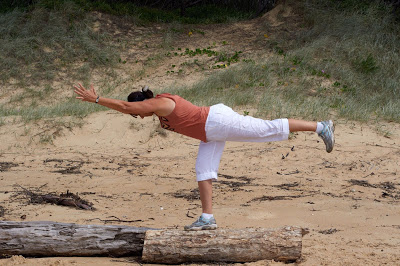by Ram
 |
| Eileen Hartley, Age 57 |
Aging is associated with a number of changes in the physical body and one of them is a reduced ability to balance. Most people in the general population fail to attach importance to the ability to balance, but they should, especially as they grow older because as we age, our balance declines—and can cause falls. Every year more than one in three people age 65 years or older fall, and the risk increases with age. A simple fall can cause a serious injury to the hip, pelvis, spine, arm, hand or ankle that will require hospitalization, disability, or loss of independence and sometimes even death.
Balance is the ability to distribute our weight to enable us to hold a steady position, take turns, or move without falling. The ability to balance is determined by a complex combination of muscle strength, specific areas of the brain, visual and vestibular systems, and the nerves of joints, muscles, ligaments, and tendons that orient you in a defined space.
The vestibular system inside our ears is one of the main balance centers that detects where our body is in space. Whether we are upright (Tadasana), lying flat (Savasana), standing on our feet (as in Warrior poses), or upside down (Headstand/Handstand) is all controlled by the vestibular system. The vestibular system cross-talks with specific areas in the brain to determine our stability and for any corrective action to be taken. As we age, cells in the vestibular system degenerate, resulting in failure to detect our position in space. This affects our ability to correct any imbalances. As an example, if we happen to tilt more to the right and the vestibular system doesn’t detect this quickly, it becomes harder for the brain to take corrective measures to prevent falling to the right.
In addition to the vestibular system, the visual system also helps with balance. Our sight, including the ability to focus, and the ability to see things clearly, diminishes as we age. Furthermore, our perception of depth, night vision, and sensitivity to contrast also fail as we age. These problems can impair, blur or distort vision all of which compromises balance.
Circulatory and cardiac issues that accompany the aging process also affect balance. The problems show up as changes in blood pressure that can dip suddenly when you stand up, causing dizziness, lightheadedness, blurry vision, and even fainting. As we age, we lose muscle mass and strength and with it power to react swiftly, which ultimately affects balance. Our reflexes and coordination also slow down with age.
Other co-morbidities that accompany the aging process can interfere with balance. They include, but are not limited, to Parkinson’s disease, osteoarthritis, stroke, and multiple sclerosis. Not content with that, several medications prescribed for the above-mentioned health issues may also increase the risk of falls. The medications may damage the inner ear or trigger blurred vision, dizziness, lightheadedness, and drowsiness, all of which can result in balance issues.
But scientific studies have shown that yoga can help! In The influence of tai chi and yoga on balance and falls in a residential care setting: A randomised controlled trial. yoga has been shown to improve balance.
Another study from Australia that fetched a lot of media attention evaluated the feasibility and effectiveness of a group-based yoga program compared with the usual care among people aged 60 and over. The pilot study involving 54 people aged 60 was designed in preparation for another more detailed trial to determine if yoga prevents falls among older people. While one half of the participants participated in a twice-weekly Iyengar yoga classes for 12 weeks, the other half read an information booklet on fall prevention. At the end of the 12 weeks, the researchers compared the two groups on their ability to complete some functional tests of balance and mobility. The researchers found that the group that took part in yoga could perform significantly faster in tests involving standing and sitting down quickly without using the arms for support. The yoga group also walked significantly faster in a walking test and could stand on one leg for longer, indicating improved balance. The yoga program was also found to be safe and fun for the older participants and attendance was very good.
Thus, the above studies demonstrated the potential impact that yoga may have on improving balance and reducing fall risk. In general an asana practice that includes strength, flexibility, and a wide variety of balancing poses will help to maintain balance as we age. Check YFHA’s yoga toolbox for improving balance, starting from the toes all the way up to the space of your thoughts.
Follow Yoga for Healthy Aging on Facebook ° To order Yoga for Healthy Aging: A Guide to Lifelong Well-Being, go to Amazon, Shambhala, Indie Bound or your local bookstore.


I like to include a simple closed eye balance in each class in order to focus on physical proprioceptirs with no visual feedback. As vision changes as with age that may be crucial for some of us.
I do the same…periodically doing 1 Sun A or B with eyes closed, standing poses with eyes closed, etc. Helps to develop an internal feel for one's body in space. Drishti is great, but as we age our vision can get worse, especially depth perception and double vision. Learning to not rely on spotting visually for balance is important.